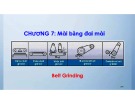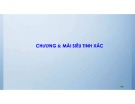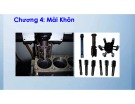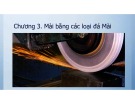
323
CHƯƠNG 10: ĐÁNH BÓNG
Polishing

Polishing
•Polishing and buffing are finishing processes for
smoothing a workpiece's surface using an abrasive and
a work wheel or a leather strop. Technically polishing
refers to processes that use an abrasive that is glued to
the work wheel, while buffing uses a loose abrasive
applied to the work wheel.
•Polishing is a more aggressive process while buffing is
less harsh, which leads to a smoother, brighter finish.A
common misconception is that a polished surface has
a mirror bright finish, however most mirror bright finishes
are actually buffed.

Process
•The condition of the material at hand determines what type of
abrasive will be applied. The first stage, if the material is
unfinished, starts with a rough abrasive (perhaps 60 or 80 grit)
and each subsequent stage uses a finer abrasive, such as 120,
180, 220/240, 320, 400 and higher grit abrasives, until the desired
finish is achieved. The rough (i.e. large grit) passes remove
imperfections within the metal surface like pits, nicks, lines and
scratches.

Applications
•Polishing may be used to enhance and restore the looks of
certain metal parts or object on cars and other vehicles,
handrails, cookware, kitchenware, and architectural metal. In
other applications such as pharmaceutical, dairy, and specialty
plumbing, pipes are buffed to help prevent corrosion and to
eliminate locations where bacteria or mold may reside. Buffing is
also used to manufacture light reflectors.

Common plastic polishing methods
•Flame polishing uses a
hot flame to flow a
plastic surface. Operator
skill is critical with this
method. When done
properly, flame plastic
polishing produces the
clearest finish, especially
when polishing acrylic.
Flat external surfaces are
the most applicable
configuration for this
method.











![Bài tập tối ưu trong gia công cắt gọt [kèm lời giải chi tiết]](https://cdn.tailieu.vn/images/document/thumbnail/2025/20251129/dinhd8055/135x160/26351764558606.jpg)














